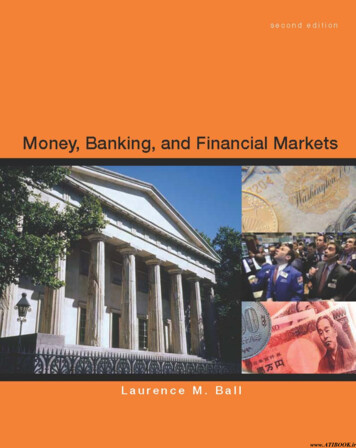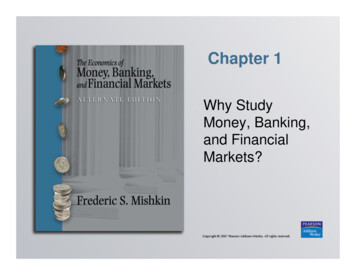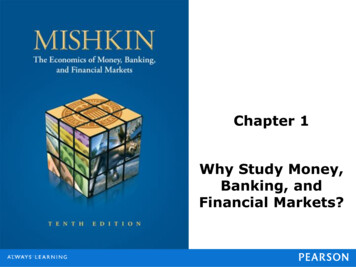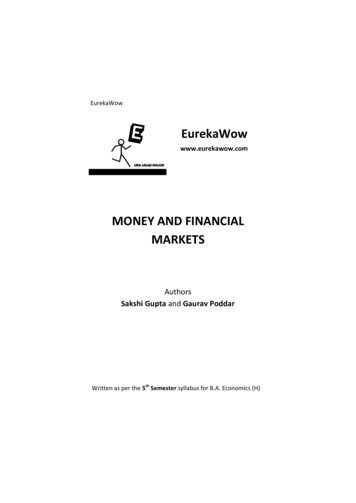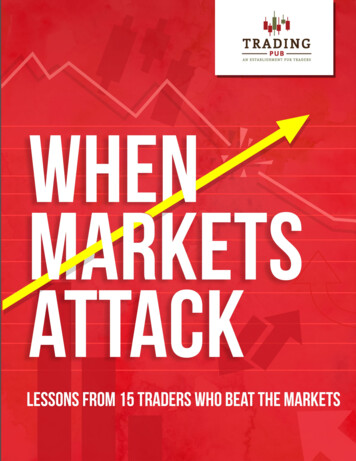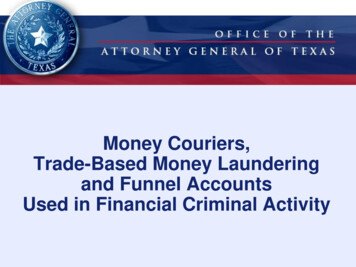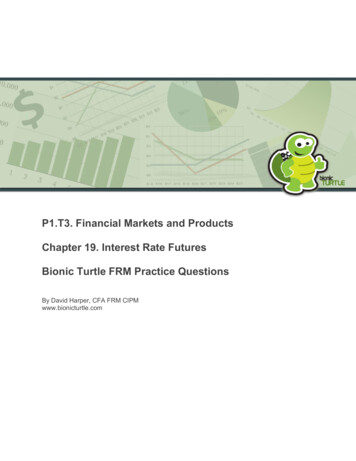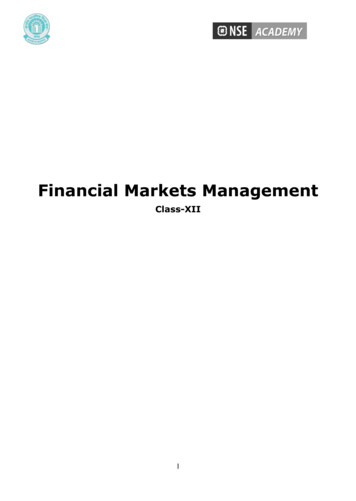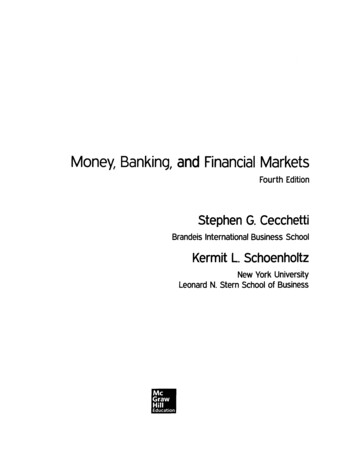
Transcription
Money, Banking, and Financial MarketsFourth EditionStephen G. CecchettiBrandeis International Business SchoolKermit L. SchoenholtzNew York UniversityLeonard N. Stern School of BusinessMcGrawHillEducation
Brief ContentsPart /Money and the Financial Systemchapter 1chapter 2chapter 3Part//Future Value, Present Value, and Interest Rates 75Understanding Risk 104Bonds, Bond Prices, and the Determination of Interest RatesThe Risk and Term Structure of Interest Rates 162Stocks, Stock Markets, and Market Efficiency 189Derivatives: Futures, Options, and Swaps 214Foreign Exchange 240Financial InstitutionschapterchapterchapterchapterParXIVAn Introduction to Money and the Financial System 2Money and the Payments System 23Financial Instruments, Financial Markets, and Financial Institutions 45Interest Rates, Financial Instruments, and Financial Marketschapter 4chapter 5chapter 6chapter 7chapter 8chapter 9chapter 10Part III111121314133267The Economics of Financial Intermediation 268Depository Institutions: Banks and Bank ManagementFinancial Industry Structure 327Regulating the Financial System 359Central Banks, Monetary Policy, and Financial Stability295393chapter15 Central Banks in the World Today 394chapter 16 The Structure of Central Banks: The Federal Reserve and theEuropean Central Bank 421chapter 17 The Central Bank Balance Sheet and the Money Supply Processchapter 18 Monetary Policy: Stabilizing the Domestic Economy 481chapter 19 Exchange-Rate Policy and the Central Bank 522PartyModern Monetary Economicschapter 20chapter 21chapter 22chapter 2374450552Money Growth, Money Demand, and Modern Monetary PolicyOutput, Inflation, and Monetary Policy 581Understanding Business Cycle Fluctuations 617Modern Monetary Policy and the Challenges Pacing CentralBankers 649553xxvii
ContentsAbout the Authors ivPreface vLearning Tools Walkthrough xivPart IMoney and the Financial SystemCHARTER i1An Introduction to Money and the Financial System 2The Six Parts of the Financial System 3The Five Gore Principles of Money and Banking 5Core Principle 1: Time Has Value 5Core Principle 2: Risk Requires Compensation 6Core Principle 3: Information 1s the Basis for Decisions 7Core Principle 4: Markets Determine Prices and Allocate ResourcesCore Principle 5: Stability Improves Weifare 8Special Features of This Book 9Your Financial World 9Applying the Concept 10Lessonsfrom the Crisis 10In the News 11Tools of the Trade 11End-of-Chapter Sections 11The Organization of This Book 13Learning Tools Your Financial World: Guard Your Identity710Terms 14Using FRED: Codes for Data in This Chapter 14Chapter Lessons 15Conceptual and Analytical Problems 15Data Exploration 16APPENDIX A TO CHAPTER 1: Measuring Economic Activity, Prices, and theInflation Rate 18APPENDIX B TO CHAPTER 1: Using FRED 21CHAPTER 2Money and the Payments System 23Money and How We Use It 24Means ofPayment 24Unit of Account 24Store of Value 25The Payments System 26Commodity and Fiat Monies 26
xxx I ContentsChecks 28Electronic Payments 31The Future of Money 33Measuring Money 35leommg Tbok Your Financial World: Debit Cards versus Credit Cards 25Your Financial World: Paper Checks Become Digital Images 30Lessons from the Crisis: Market Liquidity, Funding Liquidity and MakingMarkets 32In the News: Airtime Is Money: The Other Type of Mobile Money 34Tools of the Trade: The Consumer Price Index 38Applying the Concept: Where Are All Those 100 Bills? 39Terms 41Using FRED: Codes for Data in This Chapter 42Chapter Lessons 42Conceptual and Analytical Problems 43Data Exploration 44CHAPTER 3Financial Instruments, Financial Markets, and Financial InstitutionsFinancial Instruments 47Uses of Financial Instruments 48Characteristics of Financial Instruments: Standardization andInformation 49Underlying versus Derivative Instruments 51A Primer for Valuing Financial Instruments 51Examples of Financial Instruments 52Financial Markets 54The Role of Financial Markets 55The Structure of Financial Markets 57Characteristics of a Well-Run Financial Market 64Financial Institutions 64The Role of Financial Institutions 66The Structure ofthe Financial Industry 66Learning Tools Lessons from the Crisis: Leverage50Your Financial World: Disability Income Insurance 53Tools of the Trade: Trading in Financial Markets 56In the News: High-Frequency Trading 61Lessons from the Crisis: Interbank Lending 62Lessons from the Crisis: Shadow Banks 65Your Financial World: Shop for a Mortgage 6845
Contents I xxxiTerms 69Using FRED: Codes for Data in This Chapter 69Chapter Lessons 70Conceptual and Analytical Problems 71Data Exploration 73Part IIInterest Rates, Financial Instruments, and Financial MarketsCHAPTER 474Future Value, Present Value, and Interest Rates 75Valuing Monetary Payments Now and in the Future 76Future Value and Compound Interest 76Present Value 80Applying Present Value 84Internal Rate of Return 85Bonds: The Basics 88Real and Nominal Interest Rates 92Learning Tools Your Financial World: How Long Does Your Investment Take to Double?Lessons from the Crisis: Risk Taking and the Search for Yield 81Tools of the Trade: Computing Compound Annual Rates 84Your Financial World: Should You Buy a New Car Now or Wait?Applying the Concept: Early Retirement 877985In the News: Economic Scene: Pentagon Shows That It Doesn't Always Payto Take the Money and Run 88Your Financial World: Pay Off Your Credit Card Debt as Fast as You Can 93Applying the Concept: High Interest Rates, Low Interest Rates 95Terms 96Using FRED: Codes for Data in This Chapter 97Chapter Lessons 97Conceptual and Analytical Problems 98Data Exploration 100APPENDIX TO CHAPTER 4: The Algebra of Present-Value FormulasCHAPTER 5Understanding Risk 104Defining Risk 105Measuring Risk 106Possibilities, Probabilities, and Expected Value 106Measures ofRisk 109Risk Aversion, the Risk Premium, and the Risk-Return TradeoffSources of Risk: Idiosyncratic and Systematic Risk 118Reducing Risk through Diversification 120Hedging Risk 120Spreading Risk 121102117
xxxii I ContentsLearning Tools Applying the Concept: It's Not Just Expected Return That Matters 107Your Financial World: Choosing the Right Amount of Car Insurance IIITools of the Trade: The Impact of Leverage on Risk 114Lessons from the Crisis: Systemic Risk 116Your Financial World: Your Risk Tolerance 119In the News: Risk-On, Risk-Off May Be Ending 122Terms 124Using FRED: Codes for Data in This Chapter 125Chapter Lessons 125Conceptual and Analytical Problems 126Data Exploration 128APPENDIX A TO CHAPTER 5: A Quick Test to Measure Investment RiskTolerance 129APPENDIX B TO CHAPTER 5: The Mathematics of Diversification 131CHAPTER 6Bonds, Bond Prices, and the Determination of Interest Rates 133Bond Prices 134Zero-Coupon Bonds 134Fixed-Payment Loans 135Coupon Bonds 136Consols 136Bond Yields 137Yield to Maturity 137Current Yield 138Holding Period Returns 139The Bond Market and the Determination of Interest Rates 141Bond Supply, Bond Demand, and Equilibrium in the Bond Market 141Factors That Shift Bond Supply 145Factors That Shift Bond Demand 146Understanding Changes in Equilibrium Bond Prices and Interest Rates 149Why Bonds Are Risky 150Default Risk 152Inflation Risk 154Interest-Rate Risk 155Learning Tools Your Financial World: Know Your Mortgage136Tools of the Trade: Reading the Bond Page 142Your Financial World: Understanding the Ads in the NewspaperApplying the Concept: When Russia Defaulted 151Applying the Concept: Securitization 153Your Financial World: Bonds Indexed to Inflation148154In the News: Gross's Burning Bond Market Fails to Frighten Investors 156
Contents I xxxiiiTerms 157Using FRED: Codes for Data in This Chapter 157Chapter Lessons 158Conceptual and Analytical Problems 158Data Exploration 161CHAPTER 7The Risk and Term Structure of Interest Rates 162Ratings and the Risk Structure of Interest Rates 163Bond Ratings 163Commercial Paper Ratings 167The Impact of Ratings on Yields 168Differences in Tax Status and Municipal Bonds 171The Term Structure of Interest Rates 172The Expectations Hypothesis 172The Liquidity Premium Theory 177The Information Content of Interest Rates 179Information in the Risk Structure of Interest Rates 179Information in the Term Structure of Interest Rates 180Learning Tools Lessons from the Crisis: Subprime Mortgages 165Lessons from the Crisis: Rating Agencies 166Your Financial World: Your Credit Rating 169Lessons from the Crisis: Asset-Backed Commercial Paper 171Tools of the Trade: Reading Charts 176Applying the Concept: The Flight to Quality 179In the News: Banks Decline Yield Curve Invitation to Party On 182Terms 184Using FRED: Codes for Data in This Chapter 185Chapter Lessons 185Conceptual and Analytical Problems 186Data Exploration 188CHAPTER 8Stocks, Stock Markets, and Market Efficiency 189The Essential Characteristics of Common Stock 190Measuring the Level of the Stock Market 193The Dow Jones Industrial Average 194The Standard & Poor's 500 Index 194Other U.S. Stock Market Indexes 196World Stock Indexes 196Valuing Stocks 198Fundamental Value and the Dividend-Discount ModelWhy Stocks Are Risky 200Risk and the Value of Stocks 202The Theory of Efficient Markets 203198
xxxiv I ContentsInvesting in Stocks for the Long Run 205The Stock Market's Role in the Economy 208igammg TWa Your Financial World: A Home Is a Place to Live 192Tools of the Trade: Reading Stock Indexes in the Business News 195Your Financial World: Beware Percentage Changes 201Applying the Concept The Chinese Stock Market 203Your Financial World: Should You Own Stocks? 206In the News: Bubble Spotting 207Applying the Concept What Was the Internet Bubble All About?209Terms 210Using FRED: Codes for Data in This Chapter 210Chapter Lessons 210Conceptual and Analytical Problems 211Data Exploration 213CHAPTER 9Derivatives: Futures, Options, and Swaps 214The Basics: Defining Derivatives 215Forwards and Futures 216Margin Accounts and Marking to Market 218Hedging and Speculating with Futures 219Arbitrage and the Determinants of Futures Prices 219Options 222Calls, Puts, and All That: Definitions 222Using Options 223Pricing Options: Intrinsic Value and the Time Value of the OptionThe Value of Options: Some Examples 228Swaps 230Interest-Rate Swaps 230Credit-Default Swaps 234Afammg Tbok Lessons from the Crisis: Central Counterparties and Systemic RiskYour Financial World: Should You Believe Corporate FinancialStatements? 224225220Your Financial World: Should You Accept Options as Part of Your Pay?Applying the Concept: What Was Long-Term Capital ManagementDöing? 231In the News: No Insurance Pay-Out on Greek DebtTerms 235Using FRED: Codes for Data in This ChapterChapter Lessons 236Conceptual and Analytical Problems 237Data Exploration 239236233228
Contents I xxxvCHAPTER 10 Foreign Exchange 240Foreign Exchange Basics 242The Nominal Exchange Rate 242The Real Exchange Rate 244Foreign Exchange Markets 245Exchange Rates in the Long Run 246The Law of One Price 246Purchasing Power Parity 249Exchange Rates in the Short Run 253The Supply of Dollars 253The Demandfor Dollars 253Equilibrium in the Market for Dollars 254Shifts in the Supply ofand Demandfor Dollars 254Explaining Exchange Rate Movements 256Government Policy and Foreign Exchange Intervention 258Learning Tools Tools of the Trade: Following Exchange Rates in the NewsYour Financial World: Investing Abroad 248Applying the Concept: The Big Mac Index 252246Your Financial World: Don't Bet on Exchange Rates 254Lessons from the Crisis: Currency Risk and Rollover Risk 257In the News: Foreign Exchange: Neighbors Show Little Appetite for Brazil's"War 259Terms 260Using FRED: Codes for Data in This Chapter 260Chapter Lessons 260Conceptual and Analytical Problems 261Data Exploration 264APPENDIX TO CHAPTER 10: Interest-Rate Parity and Short-Run Exchange RateDetermination 265Part IIIFinancial Institutions267CHAPTER 11 The Economics of Financial Intermediation 268The Role of Financial Intermediaries 270Pooling Savings 273Safekeeping, Payments System Access, and AccountingProviding Liquidity 275Diversifying Risk 276Collecting and Processing Information 276Information Asymmetries and Information Costs 277Adverse Selection 278Solving the Adverse Selection Problem 280Moral Hazard: Problem and Solutions 283273
xxxvi I ContentsFinancial Intermediaries and Information Costs 286Screening and Certifying to Reduce Adverse Selection 286Monitoring to Reduce Moral Hazard 287How Companies Finance Growth and Investment 289Learning Tools Your Financial World: Your First Credit Card 274Applying the Concept: The Madoff Scandal 278Your Financial World: Private Mortgage Insurance 280Applying the Concept: Deflation, Net Worth, and Information Costs 281Lessons from the Crisis: Information Asymmetry and Securitization 285In the News: China Shadow Bankers Go Online as Peer-to-Peer SitesBoom 288Terms 290Using FRED: Codes for Data in This ChapterChapter Lessons 290Conceptual and Analytical Problems 291Data Exploration 293290CHAPTER 12 Depositor Institutions: Banks and Bank Management 295The Balance Sheet of Commercial Banks 296Assets: Uses of Funds 296Liabilities: Sources of Funds 299Bank Capital and Profitability 303Off-Balance-Sheet Activities 306Bank Risk: Where It Comes from and What to Do about It 308Liquidity Risk 308Credit Risk 312Interest-Rate Risk 312Trading Risk 315Other Risks 317Lfammg Tbok Your Financial World: Choosing the Right Bank for You 300Tools of the Trade: A Catalog of Depository Institutions 304Applying the Concept: Growth and Banking in China and IndiaYour Financial World: The Cost of Payday Loans 307Lessons from the Crisis: Insufficient Bank Capital 314In the News: Lessons from the London Whale 316Applying the Concept: The Tri-Party Repo Market 319Terms320Using FRED: Codes for Data in This Chapter 321Chapter Lessons 321Conceptual and Analytical Problems 322Data Exploration 325306
Contents I xxxviiCHAPTER 13 Financial Industry Structure 327Banking Industry Structure 329A Short History ofU.S. Banking 329Comp
Money, Banking, and Financial Markets Fourth Edition Stephen G. Cecchetti Brandeis International Business School Kermit L. Schoenholtz New York University Leonard N. Stern School of Business Mc Graw Hill Education . Brief Contents Part / Part// Part III ParXIV Party Money and the Financial System 1 chapter 1 An Introduction to Money and the Financial System 2 chapter 2 Money and the Payments .

